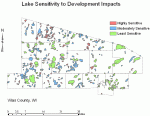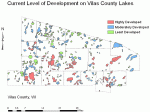By merging economic valuation techniques used by social scientists and limnological data obtained via satellite, NTL-LTER has recently demonstrated important economic and ecological links among property valuation, shoreline zoning regulations, and water quality. In light of the rapid development of the lakes of northern Wisconsin, counties have created lake classifications and shoreline restrictions to reduce ecological impacts.
Vilas County, with the Wisconsin Department of Natural Resources’ help, was one of the first to institute a comprehensive lake classification scheme in which lakes are rated according to their sensitivity to and current level of development. Sensitive lakes (typically the smallest, see Fig. 1) with low levels of current development (Fig. 2) have the greatest restrictions. Economically, the most significant restriction associated with lake classification is the minimum frontage requirement. Current state law sets the minimum frontage requirement at 100 feet. The lake classification scheme requires additional frontage of 50, 100, or 200 feet depending on the class.
Both economic theory and common sense lead to the conclusion that a good portion of the economic gains and losses associated with the lake classification scheme will be capitalized in the values of shoreline property. Yet it is not clear whether the effect on property values will be positive or negative. One can anticipate a negative development effect arising because restricting an owner’s opportunity to do with his land as he pleases reduces the market value of the land. On the other hand, to the extent that all other property on a lake is similarly restricted, positive benefits of natural amenities are generated, such as more scenic views and higher water clarity, and one would expect this amenity effect to be capitalized in the land value.
To disentangle the negative development effect and the positive amenity effect, we used a hedonic price equation and market sales data for 1172 lakefront properties sold before and after the classification took effect. Based on these data, percent change can be predicted for representative undeveloped parcels of lakefront property, relative to state minimum shoreline regulations. The overall effect of the lake classification on property value is positive, though the effect can also be negative on some smaller lakes with stricter regulations. Lake classification not only provides some ecosystem protection for the Vilas county lakes, but generally also raises the value of the lakes.
Another factor included in the valuation was lake water clarity, as measured by Secchi depth derived from the Satellite Lake Observatory Initiative (www.lakesat.org). Preliminary results indicate that water clarity also has a positive effect on lakeshore property values. At mean water clarity levels in Vilas lakes (3.25 meters), a 30 cm increase in Secchi depth raises the value of undeveloped lakeshore property by about 3.6 percent. This study is one of the first to demonstrate an economic link between property valuation, shoreline zoning, and water quality for any lake district and lays the groundwork for additional investigations on the interactions and feedbacks inherent in socio-economics and ecological systems.
For more information please contact Bill Provencher and Michael Papenfus, NTL.

 Enlarge this image
Enlarge this image
